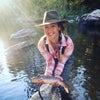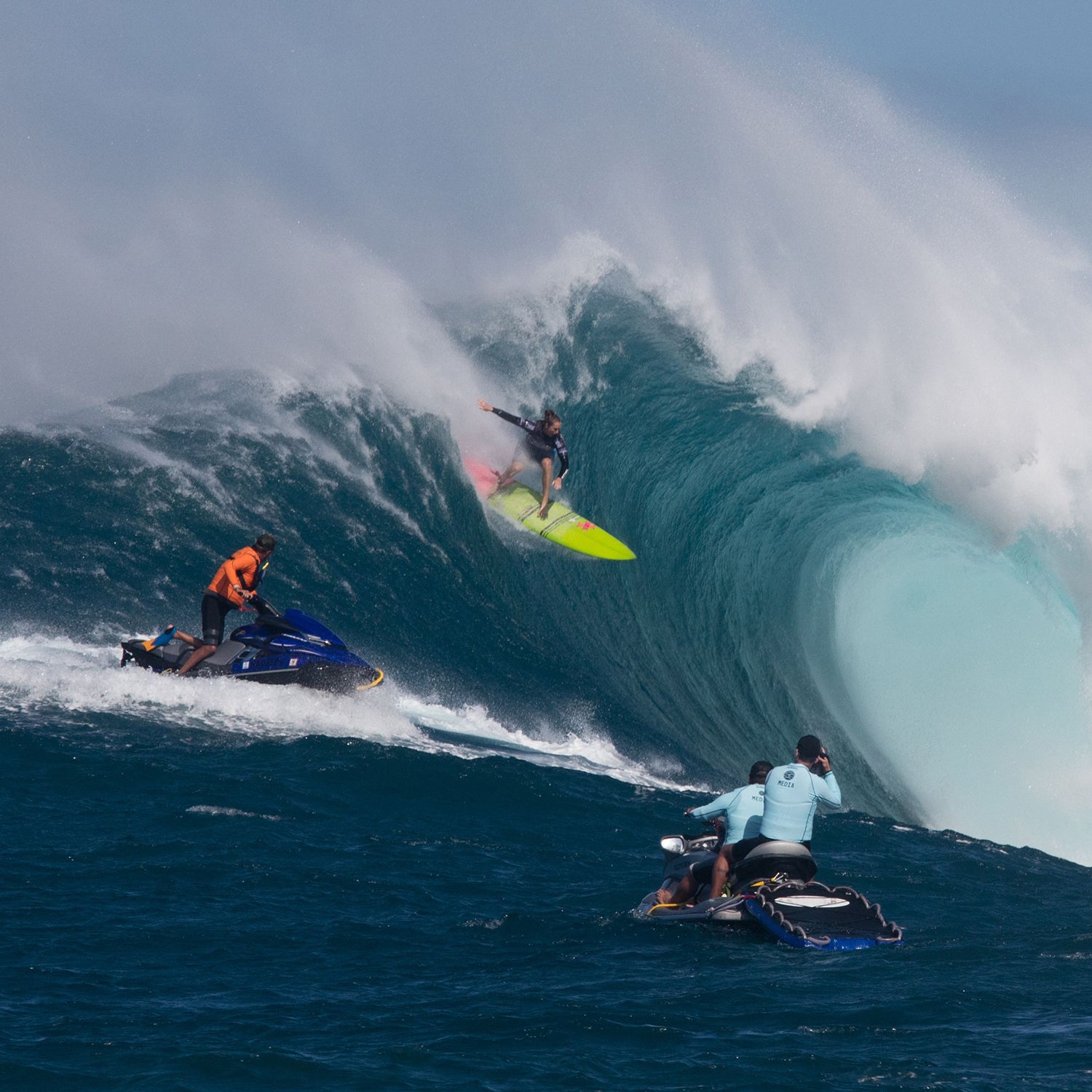It only took nineteen years, countless advocates, dozens of letters, a bankruptcy and change of ownership, plus one particularly tenacious public official, but women—for the first time ever—have been invited to compete at one of the world’s most famous big-wave breaks: Mavericks. After intense lobbying, political maneuvering, and negative press, the historically all-male contest has invited six female pros to compete in a single women’s heat, which will take place sometime between now and the middle of February, conditions permitting.
“This is a huge step forward,” says Bianca Valenti, a San Francisco-based big-wave surfer slated to compete in this year's event. “Finally, we’ve got a foot in the door. But we have a long way to go.”
The ferocious wave, off the coast of Half Moon Bay in northern California, has long been an icon of big-wave surfing. It has also become a focal point in the growing fight for gender equality in a sport with a long and colorful history of machismo. “There’s nothing more beautiful than a well-shaped girl riding a six-foot wave with the wind blowing through her hair,” wrote . “But one thing I can’t stand is girls riding (or attempting to ride) big waves.”
Flash-forward 45 years. While that attitude has eroded, it’s far from gone.
“Surfing is 20 years behind other sports,” Valenti says on a drive home from surfing Mavericks. “One day a guy told me, ‘This is a man’s playground. I don’t want to see you out here, unless I’m going out on a date with you, ‘cause you’re kinda cute.’”
Big-wave contests have run at Mavericks since 1999, when the made fliers promoting the event and the “Men Who Ride Mountains.” That was the same year that became the first woman to surf the monstrous wave, five years after bodyboarder Sarah Lucas busted the gender barrier. But competition was strictly open to dudes, who were the only ones getting invites. Contest founder Jeff Clark, a big-wave pioneer who surfed Mavericks alone for 15 years before anyone would join him, didn’t think women were good enough. “It’s not a gender thing. It’s a performance thing,” Clark told CBS—in 2016. “Women just aren’t there yet.” a year after Keala Kennelly won Barrel of the Year at the WSL Big Wave Awards, the so-called Oscars of big-wave surfing. She was chosen—over hundreds of men—in a season with a historic number of supersized rides, barrels, and wipeouts. In her acceptance speech, Kennelly thanked “…. Because that drove me to dedicate my life to proving you wrong, and it's been so damn fun.”
As if women aren’t����������� out there with men in the lineup for any big swell. “On any given day, we’re competing with the men,” Valenti says. “It’s not like a tennis court.”
The simple truth is, women have been surfing big waves for decades, despite the cultural undertow of a brotherhood that really would rather they didn’t. “Women have been expected to look good on the beach and hand the boy his towel when he gets out of the water,” says Matt Warshaw, author of the . “Women were not encouraged to go out and surf big waves during the 1960s. But there were women who did.”
“There’s nothing more beautiful than a well-shaped girl riding a six-foot wave,” wrote big-wave surfer Buzzy Trent in 1963. “But one thing I can’t stand is girls riding big waves.”
In 1959, as Joan Cleaver was still cleaning the house in a dress and pearls, Linda Benson, who would later be called the , became the first woman to surf Waimea. Around the same time, Marge Calhoun, a mother of two who didn’t pick up a surfboard until she was almost 30, was winning the Makaha International, on the west side of Oahu, Hawaii. “I loved a wave that was dramatic,” Calhoun said. “I wanted something that could knock me around.”
In the 1970s, Margo Oberg, often credited as the original female big-wave surfer, became a regular on the monstrous winter swells at Sunset Beach on Oahu’s North Shore. She raised the ante to 15-foot waves. After winning four world championships, she fell just shy of a fifth, placing second in 1982—three months after giving birth. Then came Phyllis Dameron, one of the most fearless bodyboarders (of either gender) in the history of the sport. She paddled into waves higher than 20 feet and bounced down them like a skipping stone, often passing the men below her. “I’ll go right over them, in the air if I have to,” she said.
In the 1990s, Layne Beachley and Sarah Gerhardt became tow-in pioneers. After mastering 20-footers at a North Shore break called Phantoms, Beachley had a Jet Ski sling-shot her into 25-foot waves in Todos Santos, in Baja California, and ���ϳԹ��� Log Cabins, in Hawaii. She became the first woman to conquer the “death slab” barrels at a freakish Sydney break, which pounds into a rocky shelf.
Yet during all that time, invite-only contests were closed to women. Finally, in 2010, Oregon’s Nelscott Reef Big Wave Classic became the first major event to invite women to compete. But even then there was a catch: it was only an exhibition, . Three women surfed in a one-hour heat, in conditions that blew out one male competitor’s eardrum and sent him staggering to shore, warning about the conditions. Keala Kennelly took home the win—and a prize purse of…$0.
Finally, in 2016, the first paying women’s division was added to a big-wave contest. The Peahi Challenge, one of three stops on the , invited women to compete on the 30-foot-plus waves at the Maui break Jaws. It was a bona-fide division: 12 women, plus six alternates, competing in three heats—two semi-finals and a final. Hawaii’s Paige Alms, who does construction and ding repair to supplement her pro-surfer income, landed air-drops in the howling wind and became the first women’s big-wave champion. She won . (The men’s champ bagged .)
The world of big-wave surfing appeared to be shifting, with many male pro surfers expressing support for their female counterparts. But the Mavericks door remained slammed shut. It took a politically savvy local official to pry that one open.
Jeff Clark, a big-wave pioneer, didn’t think women were good enough to surf Mavericks. “It’s not a gender thing. It’s a performance thing,” he said.
Sabrina Brennan, an elected member of the San Mateo County Harbor Commission, which also grants event permits, teamed up with several female pros, including Bianca Valenti and Keala Kennelly, to form the . She argued that public resources could not be used for discriminatory activities—a key legal point. In response to their lobbying efforts, the California Coastal Commission required Titans of Mavericks to include women competitors as a condition for renewal of the event's permit.
Here’s how Titans founder Jeff Clark responded to that news in a TV interview: “I understand what the Coastal Commission wants is more women involved in Mavericks. We’ve had women judges, we’ve had women in our water patrol, and water rescue…” Actually, no. They want to see women on the board—not the board of directors.
The contest organizer, Cartel Management, grudgingly responded by agreeing to “reach out” to female pros and allow them to compete—with the men, if they qualified. Four women made the 56-person first cut. Days later, not a single woman made the 38-surfer second cut, selected by an all-male committee. Calling B.S. on Cartel’s pseudo-meritocracy, the Committee for Equity in Women’s Surfing demanded that women compete against women, as they do in pretty much every other sport. They asked for a standard women’s division: six women, three heats.
To make a long story short, Cartel was then sued by sponsors and . The 2016-2017 Titans of Mavericks never happened. The next season, the event was picked up by the World Surf League, which invited six women to compete—against each other—in the 2017-2018 contest, renamed the Mavericks Challenge. This added a second women’s contest—and a fourth event—to the Big Wave Tour. “The timing was right,” says CEO Sophie Goldschmidt, who has held executive roles with the NBA, Adidas, and several mainstream sports. She expects the WSL to add more women’s big-wave surfing events—gradually. “We’re not going to rush. We’re going to be very thoughtful about this. Over time, I expect us to add further events as the women and the sport are ready for it, from a performance and a safety standpoint.”
The female pros say they’re stoked to compete at Mavericks, but they wish it was a legitimate multi-heat division. It’s six women and one heat—one golden hour on the waves. Compared to the three-heat, 24-man contest, it feels to some like a footnote. What they’d like to see is a multi-heat competition, where women have to surf against one another to make it to the finals. As it is, “it’s a token,” Brennan says. “Six women, one heat? That’s nowhere near equality.”
Given the sport’s history of machismo, that should surprise no one.


